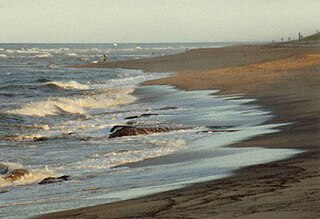
Cape Cod is a geographic cape extending into the Atlantic Ocean from the southeastern corner of mainland Massachusetts, in the northeastern United States. Its historic, maritime character and ample beaches attract heavy tourism during the summer months. The name Cape Cod, coined in 1602 by Bartholomew Gosnold, is the ninth oldest English place-name in the U.S.
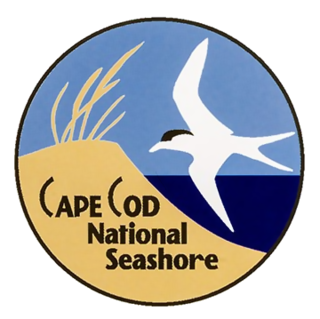
The Cape Cod National Seashore (CCNS), created on August 7, 1961 by President John F. Kennedy, encompasses 43,607 acres on Cape Cod, in Massachusetts. It includes ponds, woods and beachfront of the Atlantic coastal pine barrens ecoregion. The CCNS includes nearly 40 miles (64 km) of seashore along the Atlantic-facing eastern shore of Cape Cod, in the towns of Provincetown, Truro, Wellfleet, Eastham, Orleans and Chatham. It is administered by the National Park Service.

Nauset Light, officially Nauset Beach Light, is a restored lighthouse on the Cape Cod National Seashore near Eastham, Massachusetts, erected in 1923 using the 1877 tower that was moved here from the Chatham Light. It is listed on the National Register of Historic Places. The tower is a cast-iron plate shell lined with brick and stands 48 feet (15 m) high. The adjacent oil house is made of brick and has also been restored. Fully automated, the beacon is a private aid to navigation. Tours of the tower and oil house are available in summer from the Nauset Light Preservation Society which operates, maintains and interprets the site. The tower is located adjacent to Nauset Light Beach.
The Trust for Public Land is a U.S. nonprofit organization with a mission to "create parks and protect land for people, ensuring healthy, livable communities for generations to come". Since its founding in 1972, The Trust for Public Land has completed 5,000 park-creation and land conservation projects across the United States, protected over 3 million acres, and helped pass more than 500 ballot measures—creating $70 billion in voter-approved public funding for parks and open spaces. The Trust for Public Land also researches and publishes authoritative data about parks, open space, conservation finance, and urban climate change adaptation. Headquartered in San Francisco, the organization is among the largest U.S. conservation nonprofits, with approximately 30 field offices across the U.S., including a federal affairs function in Washington, D.C.

The Cape Cod Rail Trail (CCRT) is a 25.5-mile (41.0 km) paved rail trail located on Cape Cod in Massachusetts. The trail route passes through the towns of Yarmouth, Dennis, Harwich, Brewster, Orleans, Eastham, and Wellfleet. It connects to the 6-plus mile (10 km) Old Colony Rail Trail leading to Chatham, the 2 mile Yarmouth multi-use trail, and 8 miles (13 km) of trails within Nickerson State Park. Short side trips on roads lead to national seashore beaches including Coast Guard Beach at the end of the Nauset Bike Trail in Cape Cod National Seashore. The trail is part of the Claire Saltonstall Bikeway.

Race Point Light is a historic lighthouse on Cape Cod, in Provincetown, Massachusetts; it is on the National Register of Historic Places. The original tower, first illuminated in 1816, was replaced in 1876 with the current 45-foot tall iron-plated tower and a new keeper's dwelling. The American Lighthouse Foundation operates the property and rents out two buildings for overnight stays. The actual light is maintained by the Coast Guard. The site is reached by walking about 45 minutes over sand; with a National Park Service Oversand Permit, a four-wheel-drive vehicle can be used.

The Highland Light is an active lighthouse on the Cape Cod National Seashore in North Truro, Massachusetts. The current tower was erected in 1857, replacing two earlier towers that had been built in 1797 and 1831. It is the oldest and tallest lighthouse on Cape Cod.

The Atwood–Higgins Historic District encompasses a historic property with deep colonial roots in Cape Cod National Seashore. Located on Bound Brook Island on the west side of Wellfleet, Massachusetts, the centerpiece of the district is the Thomas Atwood House, built c. 1730. The property is emblematic of Cape Cod's colonial origins and its later transformation into a summer resort area. The house was listed on the National Register of Historic Places in 1976; the district was listed in 2010. The property is open for guided tours by the National Park Service on a seasonal basis.
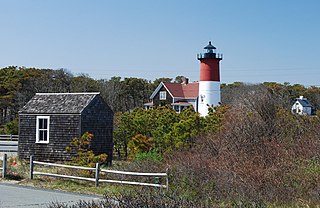
The French Cable Hut is a historic building in Cape Cod National Seashore, near the Nauset Beach Light in Eastham, Massachusetts. Built in 1891, the hut formed a linkage point in the transatlantic telegraph cable of the French Cable Company connecting the cable, where it came ashore near the present site to its main station in Orleans. After the cable was abandoned in 1932, the hut was adapted for residential use. It has since been restored to its turn-of-the-century appearance by the National Park Service. The building was listed on the National Register of Historic Places in 1976.
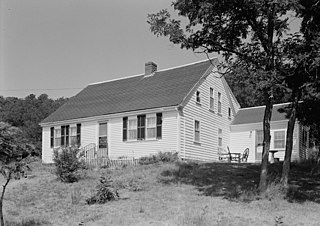
The Jedediah Higgins House is a historic house on Higgins Hollow Road in North Truro, Massachusetts. It is one of the least altered 19th-century Cape style houses in the Cape Cod National Seashore, and an excellent early example of that style. It is a 1+1⁄2-story post-and-beam house, whose front facade typifies the Cape style: a central doorway flanked by windows on either side. Its interior floor plan is also typical, with two rooms on the south side and one large one to the north, with a central chimney. Interior finishes have also been preserved, including wood flooring, paneling, and wainscoting.
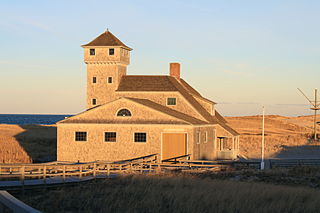
The Old Harbor U.S. Life Saving Station is a historic maritime rescue station and museum, located at Race Point Beach in Provincetown, Massachusetts. Built in 1897, it was originally located at Nauset Beach near the entrance to Chatham Harbor in Chatham, Massachusetts. It was used by the United States Life-Saving Service (USLSS), and then by its successor, the United States Coast Guard (USCG), as the Old Harbor Coast Guard Station. The station was decommissioned in 1944, abandoned and sold as surplus in 1947, and was used as a private residence for the next twenty-six years.

The Edward Penniman House and Barn is a historic site in Eastham, Massachusetts, United States, on Fort Hill, which is currently protected by the Cape Cod National Seashore and home to Indian Rock.

The Dune Shacks of Peaked Hill Bars Historic District includes dune shacks that were home to American artists and writers from the 1920s to present day. The historic district, located in the Outer Cape towns of Provincetown and Truro, comprises 1,950 acres of the Cape Cod National Seashore. It was listed on the National Register of Historic Places in 2012. The name is derived from a Life-Saving Station known as Peaked Hill Bars that was established in 1882 on the lower cape.

The Ruth and Robert Hatch Jr. House is a historic house at 309 Bound Brook Way in Wellfleet, Massachusetts. It is one of a modest number of surviving houses in Wellfleet that combine elements of Modern architecture with traditional Cape Cod architecture. This single story wood-frame house was built in 1961 on Bound Brook Island to a design by local architect Jack Hall. Extremely rustic in appearance, its exterior is sheathed in vertical boards and its windows have working shutters but no glass, resulting in a sharply vertical appearance. The structure consists of three rectangular sections of different sizes that are based on modular 7' by 7' squares; the main public living space is 35' by 49', the master bedroom is 7' by 21', and the guest bedrooms are in a block that is 7' by 14'. The house, which is within the bounds of the Cape Cod National Seashore, was sold by the Hatches to the National Park Service, but they retain occupancy rights.

The Samuel and Minette Kuhn House is a historic house in Wellfleet, Massachusetts. It is one of a modest number of surviving houses in Wellfleet that combine elements of Modern architecture with traditional Cape Cod architecture. The single-story wood-frame house was built in 1960 to a design by Nathaniel Saltonstall, founder of Boston's Institute of Contemporary Art. The Kuhns were exposed to Saltonstall's work when they stayed at The Colony, another property he designed that is located nearby on Griffins Island. The house incorporates Bauhaus design principles of simplicity and economy, and is based around the idea of square modules, which are repeated on small, medium and large scales, affecting the room shapes and sizes, windows, and interior furnishings and decorations. The house, which is within the bounds of the Cape Cod National Seashore, was sold by the Kuhns to the National Park Service in 1973, but they retained right of occupancy for 25 years. The Park Service began using the property for employee housing in 2003.
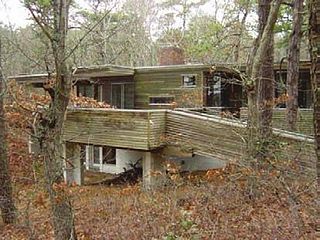
The Peter Kugel House, also known as the Kugel-Gips House, is a historic house at 188 Way 626, Wellfleet, Massachusetts, in Cape Cod National Seashore. It is one of a modest number of surviving houses in Wellfleet that combine elements of Modern architecture with traditional Cape Cod architecture. This house was built in 1970 to a design by architect Charlie Zehnder, who took his design inspiration for it from the Fallingwater estate designed by Frank Lloyd Wright.

The Anthony and Allison Sirna Studio is a historic artist's studio at 60 Way #4 in Wellfleet, Massachusetts. It is one of a modest number of surviving buildings in Wellfleet that combine elements of Modern architecture with traditional Cape Cod architecture. The studio was built in 1960 to a design by Victor Civkin; it has a trapezoidal plan with nine large vertical window bays. The building is within the bounds of the Cape Cod National Seashore, and is owned by the National Park Service.

The Paul and Madeleine Weidlinger House, also known simply as the Weidlinger House, is a historic house at 54 Valley Road in Wellfleet, Massachusetts. It is one of a modest number of surviving houses in Wellfleet that combine elements of Modern architecture with traditional Cape Cod architecture. The single story wood-frame house was built in 1954 by designer Paul Weidlinger for his family's use. It is located on a steep grade overlooking Higgins Pond, with one end projecting over the grade. A deck wraps around three sides of the house, and large glass doors give views of the surrounding landscape. The house, which is within the bounds of the Cape Cod National Seashore, was donated to the National Park Service in 1973 by Madeleine Weidlinger. The house is the subject of a 2012 lease agreement between the Park Service and the Cape Cod Modern House Trust.
Joan Kent Dillon was a teacher, a nationally known historic preservation activist and an author.

Josephine Del Deo, born Josephine Alice Couch, was an American artist, writer, and activist in preserving the Cape Cod National Seashore and the town of Provincetown, Massachusetts.

















